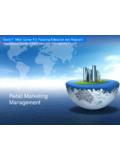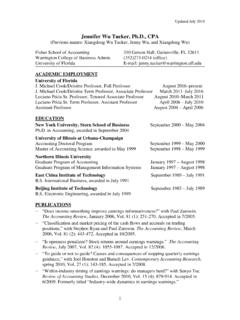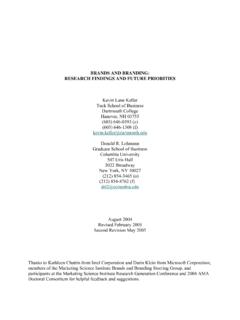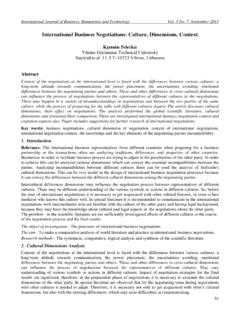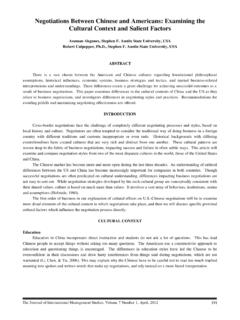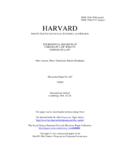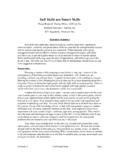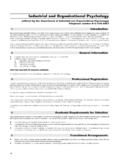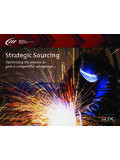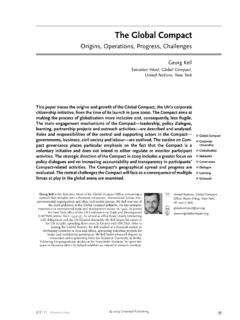Transcription of HUMAN RESOURCE MANAGEMENT IN MULTINATIONAL …
1 1 HUMAN RESOURCE MANAGEMENT IN MULTINATIONAL RETAIL ENTERPRISES (MNREs) Segment 2 Approaches to IHRM: Strategies, Structures and Evolution Over Time SEGMENT OBJECTIVES 1. Understand various approaches to organizing the IHRM practice ( , deployment of expatriates, local MANAGEMENT and staffing, degree and execution of centralized control) 2. Link to specific countries and cultures, with specific focus on China 3. Understand HR implications of strategic decisions about how to execute international expansion ( , re-creating existing model offshore, customizing model to locale, franchising) 4. Explore natural evolution of HR practice over time and experience in host country how IHRM practice must reflect and support this 5. Understand the movement from initial international expansion to true transnational status, including HRM implications READINGS AND PREPARATION International HUMAN RESOURCE MANAGEMENT (Fifth Edition), Peter J.
2 Dowling, Marion Festing, and Allen D. Engle, Sr., South-Western Cengage Learning, Mason, OH, 2009, ISBN13: 978-0-324-58034-1, ISBN10: 0-324-58034-7, pages 26-41 The Retail Revolution: How Walmart Created a Brave New World of Business, 1st ed., Nelson Lichtenstein, Metropolitan Books/Henry Holt, 2009, ISBN13: 978-0-8050-7966-1, Chapter 6 Walmart s Long March to China , pp. 149-178 PERIPHERALS (UNDER DEVELOPMENT) Video segments of IHRM executives discussing different approaches to structuring the HR function link to corporate strategy, specific country requirements, stage of international expansion PowerPoint slides to support presentation INSTRUCTOR NOTES POWERPOINT SLIDES IHRM Organizational Challenges The focus here is on internal and organizational structure and roles for IHRM. These occur in a broader social and cultural Duplicate and insert Fig. 2-1 from Dowling , p. 26 Include credits for all these slide duplications 2 context, as discussed earlier, and these internal and external factors are highly interactive.
3 The chart shown shows just some of the issues that must be addressed in establishing an effective IHRM practice and structure, combining both internal and external pressures and demands. Few of these are mutually exclusive. Rather they require simultaneous attention. [Instructor: Discuss some of the items show, with a focus on how they impact organizational and structural decisions.] There is, however, a general progression of HR practice implementation steps that, despite differences among companies on the dimensions shown, does seem to occur with some frequency. It is by no means the same for all MNREs or other international firms. There are variations in speed and the particular approach selected. For example, some MNREs elect to do rapid international expansion through acquisition of an existing retailer in the host country, and more-or-less adoption of existing HR processes in place. However, even this approach does not fully address the need for control mechanisms, administrative and information MANAGEMENT , and integration to whatever extent desired with the broader corporate structure.
4 Briscoe, Schuler and Claus (2009), pp. 44-53, describe a series of typical steps for the process of internationalization of 3 companies. It is modeled on a framework proposed by Bartlett and Ghoshal in 1998. The sequence, which we must remember, has many variations, determined by the factors in the previously slide, among others, is nonetheless useful to provide a general overview. The headings provide both a typology of organizational and structural approaches, and can broadly be thought of as a progression. (Note: This is intended to be applicable to a range of business types not just MNREs.) A Typical Sequence in the Internationalization Process 1. Internationalization through export 2. International division or global product division 3. Multi-country/multi-domestic strategy 4. Regionalization 5. The global firm 6. The transnational firm 7. The born-global firm 8. The globally integrated enterprise Internationalization through export: an early stage, often with minimal effect the organization itself.
5 Very common in an increasingly globally-sourced environment International division or global product division: Generally occurs as firms expand their sales or sourcing, making them a more significant part of the organization s functioning. This is the stage at which HR impacts become apparent, , staffing the foreign division, becoming familiar with legal, tax and other requirements for operating in a different country, etc. Multi-country/multi-domestic strategy: Creation of self-sufficient subsidiaries in foreign countries, in essence, replicating the existing corporate design and operations. HR is looked to for shared services support ( , relocation, compensation, training) and there is increased demand for integration of corporate standards and 4 approaches to doing business, with clear implications for how reconcile these expectations with local cultural and related differences. Regionalization: A variation on the above strategy, and a means for avoiding proliferation of single-market subsidiaries or related organizations.
6 Assumes that there is enough consistency across a region (culture, style, business practice, shared markets, etc.) to make this practical an assumption that may ignore very real market-by-market variation. The global firm: Firms at this stage think of the entire world as a single market, with all aspects of sourcing, production, operations, etc. assigned to wherever the firm feels it can best do so. International boundaries become less and less important, particularly as transportation, communications, and financial markets become integrated and nearly instantaneous worldwide. HR challenges abound, as companies adopt global product and branding strategies, requiring new and creative ways to structure policies, procedures, structures, training, staffing, etc. to support this global enterprise and identity. The transnational organization: While similar to the global firm in its focus, the transnational firm seeks to combine both MULTINATIONAL operation and local knowledge and sensitivities.
7 (One example is McDonald s, which has 5 successfully transplanted its highly successful operations to countries around the world, while simultaneously developing local production of many items needed for its products, work with local farmers cooperatives, tailoring the menu to suit local dietary sensibilities, etc. Still, the brand is immediately recognizable around the world, and the highly structured operational processes tried and true are part of the expansion strategy. It may be that this will become the dominant strategic approach for many firms, but it requires an extraordinary degree of international sophistication and knowledge, not least among HR practitioners. The born global firm: Oviatt and McDougall (1994) proposed this term, that has become popular in common usage. These companies leapfrog many of the earlier steps, as they were established with the very idea of competing in a truly global marketplace. Certain technology firms ( , software, cellular phones, etc.))
8 Were truly either born global, or moved very quickly through the developmental stages noted above. Increasingly, fashion apparel retailers and similar retail enterprises are following this path and/or skipping some of the intermediate steps. Again, this poses significant challenges for the HR function. The globally integrated enterprise: This model is designed on the premise that 6 every aspect of an organization, from strategy to operations, is to be considered in service of providing value to clients anywhere in the world. Thanks to technology, communications and other factors, this newly-conceived type of organization differs from the previous MULTINATIONAL models in that those typically separated strategic and MANAGEMENT decisions (done globally) from subsidiaries (which operated more or less independently, serving local markets.) Globally integrated businesses tend to operate as a network, while transnational maintain a structure that retains a corporate center Note: there is no judgment implied here that one or another of these systems is better than the other.
9 Rather, they reflect the progression of business needs, and these vary according to the nature of the firm and its products or services. However, as firms grow, and global markets of all kinds consolidate, we may expect to see more of the latter organizational styles on this list. THE OPENING ROUND: WAYS TO ENTER FOREIGN MARKETS Franchising: Locals buy the brand and apply the parent company business model. Especially popular in service industries, with notable retail-related business such as quick-service restaurants standing as prime examples. In these circumstances, the HR STRATEGIES FOR ENTERING FOREIGN MARKETS Franchising Joint Ventures (CJVs vs. EJVs) Merger and Acquisition (M&A) Wholly owned subsidiary Direct investment in new operation (WFOEs and FICEs) 7 function focuses on such areas as training, to maintain consistency and standards of the parent company critical in sustaining its brand, but efficient as a way to quickly gain market entry, with local managers who understand the business climate and culture.
10 Related models for manufacturing and other firms include licensing products or subcontracting manufacturing, thus taking advantage of often lower-cost offshore production. Joint Ventures (JVs): In prior years, JVs were one about the only legal way to establish a business in China. Direct foreign investment (DFI) was limited, so this became a dominant method of entry. There were many stories of disastrously failed marriages of this type, due in large part to the inability of Chinese and foreign partners to understand one another both literally and figuratively. In addition, There were also instances of JV partners using the local JV operation to conduct such dishonest practices as running the factory after hours to produce the licensed or contracted product, then placing the product for sale in the Chinese market, in direct competition with their supposed or other foreign partner . To be sure, there are many reasons why JVs can go sour, but selecting the proper partner is essential.
